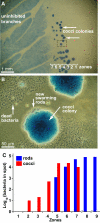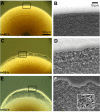Surviving bacterial sibling rivalry: inducible and reversible phenotypic switching in Paenibacillus dendritiformis - PubMed (original) (raw)
Surviving bacterial sibling rivalry: inducible and reversible phenotypic switching in Paenibacillus dendritiformis
Avraham Be'er et al. mBio. 2011.
Abstract
Natural habitats vary in available nutrients and room for bacteria to grow, but successful colonization can lead to overcrowding and stress. Here we show that competing sibling colonies of Paenibacillus dendritiformis bacteria survive overcrowding by switching between two distinct vegetative phenotypes, motile rods and immotile cocci. Growing colonies of the rod-shaped bacteria produce a toxic protein, Slf, which kills cells of encroaching sibling colonies. However, sublethal concentrations of Slf induce some of the rods to switch to Slf-resistant cocci, which have distinct metabolic and resistance profiles, including resistance to cell wall antibiotics. Unlike dormant spores of P. dendritiformis, the cocci replicate. If cocci encounter conditions that favor rods, they secrete a signaling molecule that induces a switch to rods. Thus, in contrast to persister cells, P. dendritiformis bacteria adapt to changing environmental conditions by inducible and reversible phenotypic switching.
Importance: In favorable environments, species may face space and nutrient limits due to overcrowding. Bacteria provide an excellent model for analyzing principles underlying overcrowding and regulation of density in nature, since their population dynamics can be easily and accurately assessed under controlled conditions. We describe a newly discovered mechanism for survival of a bacterial population during overcrowding. When competing with sibling colonies, Paenibacillus dendritiformis produces a lethal protein (Slf) that kills cells at the interface of encroaching colonies. Slf also induces a small proportion of the cells to switch from motile, rod-shaped cells to nonmotile, Slf-resistant, vegetative cocci. When crowding is reduced and nutrients are no longer limiting, the bacteria produce a signal that induces cocci to switch back to motile rods, allowing the population to spread. Genes encoding components of this phenotypic switching pathway are widespread among bacterial species, suggesting that this survival mechanism is not unique to P. dendritiformis.
Figures
FIG 1
The switch from rods to cocci. (A and B) Low (A) and high (B) magnifications of a competing colony. (C) Colonies formed from a single bacterium taken from zone 9 (rods) and from zone 2 (cocci). (D) Transmission electron microscopy of P. dendritiformis rod-shaped, motile cells (left). Cocci (cross-section image) are shown at the same magnification as are the rods (middle panel) and at a higher magnification, revealing incipient cell division (right). (E) The number of bacteria recovered from each zone (250- by 250-µm area) indicated in panels A and B. No bacteria were recovered from zone 1, and only cocci grew from zone 2. The proportion of rod-shaped bacteria increased with increasing distance from the inhibited interface, and only rods were recovered from zones 8 and 9.
FIG 2
Slf induces the switch from rods to cocci in a single growing colony. Purified Slf was placed 1 cm from the edge of the colony 4 days after inoculation. (A) Coccus colonies (arrows) in the inhibited regions 4 weeks after Slf introduction. (B) Higher magnification of the marked rectangle in panel A. Dead bacteria are visible in the inhibited region near coccus colonies. Rods are swarming from the edges of the coccus colonies. (C) The number of bacteria in each zone, 3 days after introduction of Slf, was determined as described for Fig. 1E.
FIG 3
Growth of P. dendritiformis rods and cocci under different conditions. Rods and cocci were cultured separately. (A) Growth of rods and cocci in LB broth at 30°C with aeration. (B) Density of cultures of rods and cocci after 18 h of growth under different conditions. Rich medium, LB broth; defined medium, RDM. Error bars are the standard deviations for 10 cases.
FIG 4
P. dendritiformis switch from cocci to rods. Low (A, C, and E)- and high (B, D, and F)-resolution pictures of a colony grown from a single coccus on LB agar. The colony contains only cocci 48 h after inoculation (A and B). At 50 h (C and D), rods, swimming individually, appear at the colony edge. Four hours later (E and F), the rods are swarming. Rods appeared nearly simultaneously (within ~10 min) at multiple locations along the edge of the same colony and other colonies grown on the same plate.
FIG 5
Rod-inducing signal (Ris). (A) Six colonies in close proximity show switching of cocci to rods sooner than does one or two colonies. Numbers indicate the number of colonies in a spot. (B) The time required for switch from cocci to rods depends on the number of coccus colonies in close proximity (as in panel A). Error bars are the standard deviations for 10 cases. (C) The time required for the switch to rods is proportional to the distance between two colonies. (D and E) Addition of Ris causes a single coccus to switch to a rod. (F) Circuit model showing the transitions between various cell forms of P. dendritiformis.
Similar articles
- Lethal protein produced in response to competition between sibling bacterial colonies.
Be'er A, Ariel G, Kalisman O, Helman Y, Sirota-Madi A, Zhang HP, Florin EL, Payne SM, Ben-Jacob E, Swinney HL. Be'er A, et al. Proc Natl Acad Sci U S A. 2010 Apr 6;107(14):6258-63. doi: 10.1073/pnas.1001062107. Epub 2010 Mar 22. Proc Natl Acad Sci U S A. 2010. PMID: 20308591 Free PMC article. - Phenotypic switching in biofilm-forming marine bacterium Paenibacillus lautus NE3B01.
Mangwani N, Kumari S, Shukla SK, Rao TS, Das S. Mangwani N, et al. Curr Microbiol. 2014 May;68(5):648-56. doi: 10.1007/s00284-014-0525-8. Epub 2014 Jan 23. Curr Microbiol. 2014. PMID: 24452426 - Structures of the DfsB Protein Family Suggest a Cationic, Helical Sibling Lethal Factor Peptide.
Taylor JD, Taylor G, Hare SA, Matthews SJ. Taylor JD, et al. J Mol Biol. 2016 Feb 13;428(3):554-560. doi: 10.1016/j.jmb.2016.01.013. Epub 2016 Jan 21. J Mol Biol. 2016. PMID: 26804569 Free PMC article. - Ribosome dependence of persister cell formation and resuscitation.
Wood TK, Song S, Yamasaki R. Wood TK, et al. J Microbiol. 2019 Mar;57(3):213-219. doi: 10.1007/s12275-019-8629-2. Epub 2019 Feb 26. J Microbiol. 2019. PMID: 30806978 Review. - Fighting bacterial persistence: Current and emerging anti-persister strategies and therapeutics.
Defraine V, Fauvart M, Michiels J. Defraine V, et al. Drug Resist Updat. 2018 May;38:12-26. doi: 10.1016/j.drup.2018.03.002. Epub 2018 Apr 10. Drug Resist Updat. 2018. PMID: 29857815 Review.
Cited by
- Identification and characterization of a highly motile and antibiotic refractory subpopulation involved in the expansion of swarming colonies of Paenibacillus vortex.
Roth D, Finkelshtein A, Ingham C, Helman Y, Sirota-Madi A, Brodsky L, Ben-Jacob E. Roth D, et al. Environ Microbiol. 2013 Sep;15(9):2532-44. doi: 10.1111/1462-2920.12160. Epub 2013 Jun 14. Environ Microbiol. 2013. PMID: 23763278 Free PMC article. - Kin Recognition in Bacteria.
Wall D. Wall D. Annu Rev Microbiol. 2016 Sep 8;70:143-60. doi: 10.1146/annurev-micro-102215-095325. Epub 2016 Jun 17. Annu Rev Microbiol. 2016. PMID: 27359217 Free PMC article. Review. - The physics of bacterial decision making.
Ben-Jacob E, Lu M, Schultz D, Onuchic JN. Ben-Jacob E, et al. Front Cell Infect Microbiol. 2014 Oct 30;4:154. doi: 10.3389/fcimb.2014.00154. eCollection 2014. Front Cell Infect Microbiol. 2014. PMID: 25401094 Free PMC article. Review. - Sibling Rivalry in Myxococcus xanthus Is Mediated by Kin Recognition and a Polyploid Prophage.
Dey A, Vassallo CN, Conklin AC, Pathak DT, Troselj V, Wall D. Dey A, et al. J Bacteriol. 2016 Jan 19;198(6):994-1004. doi: 10.1128/JB.00964-15. J Bacteriol. 2016. PMID: 26787762 Free PMC article. - CetZ tubulin-like proteins control archaeal cell shape.
Duggin IG, Aylett CH, Walsh JC, Michie KA, Wang Q, Turnbull L, Dawson EM, Harry EJ, Whitchurch CB, Amos LA, Löwe J. Duggin IG, et al. Nature. 2015 Mar 19;519(7543):362-5. doi: 10.1038/nature13983. Epub 2014 Dec 22. Nature. 2015. PMID: 25533961 Free PMC article.
References
- Dobler R, Kolliker M. 2010. Kin-selected siblicide and cannibalism in the European earwig. Behav. Ecol. 21:257–263
- vom Saal FS, Howard LS. 1982. The regulation of infanticide and parental behavior: implications for reproductive success in male mice. Science 215:1270–1272 - PubMed
- Belovsky GE, Mellison C, Larson C, Van Zandt PA. 1999. Experimental studies of extinction dynamics. Science 286:1175–1177 - PubMed
- Errington J. 2003. Regulation of endospore formation in Bacillus subtilis. Nat. Rev. Microbiol. 1:117–126 - PubMed
Publication types
MeSH terms
Substances
LinkOut - more resources
Full Text Sources
Other Literature Sources




